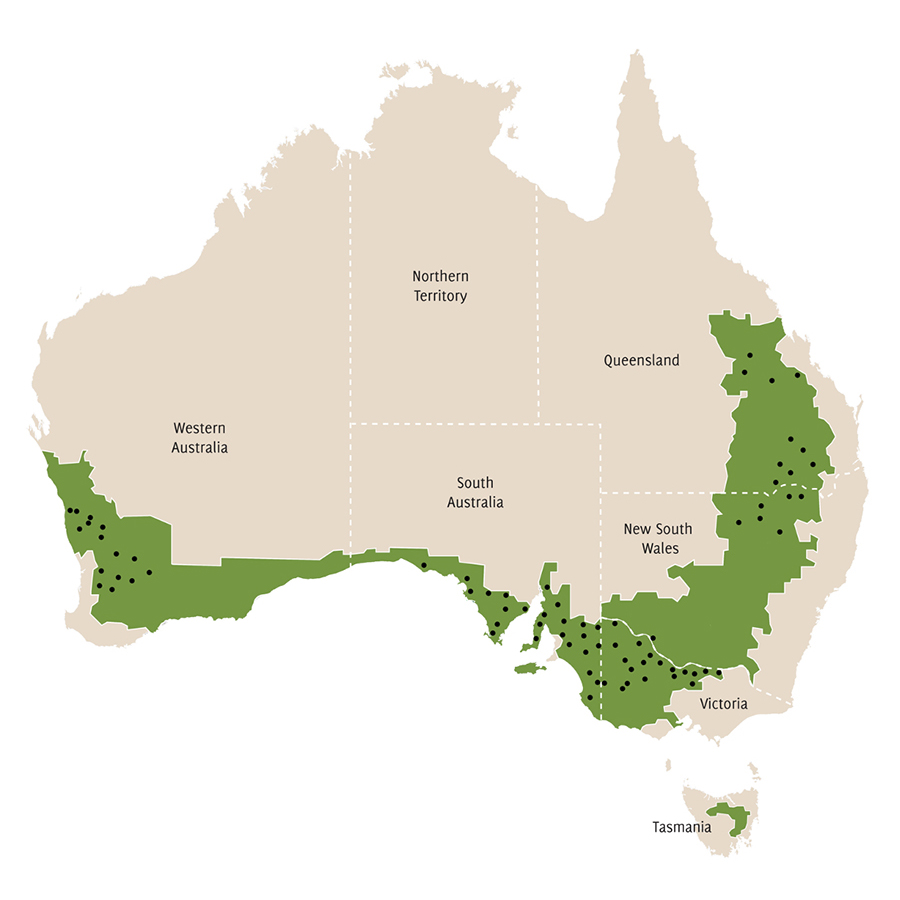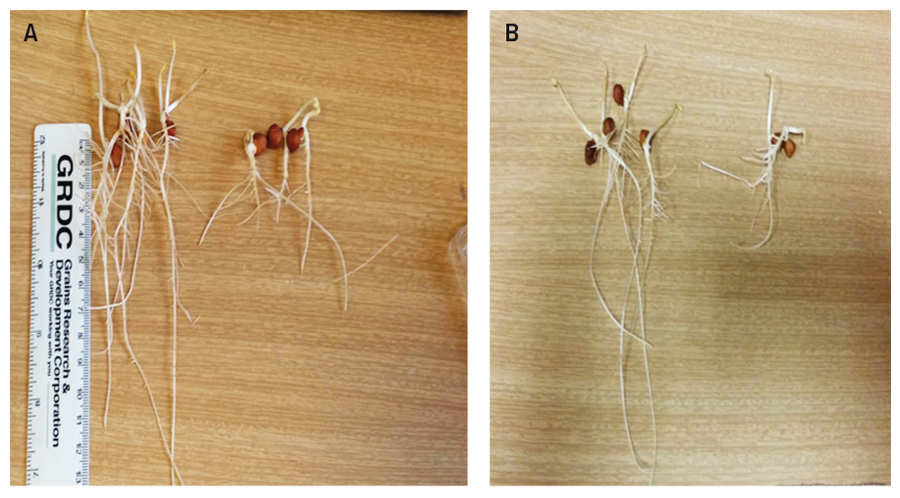Soils from across Australia have been collected in a national research effort that scientists hope will one day lead to the discovery of new rhizobia and beneficial growth-promoting soil microbes to create a step-change lift in chickpea production.
The research, led by University of Adelaide Associate Professor Matthew Denton and research fellow Dr Yi Zhou, with co-investment from GRDC through the Australian Research Council’s Legumes for Sustainable Agriculture (LSA) Research Hub, marks the start of a new collection called the Australian Agricultural Soils Bank.
Dr Denton says the collection houses 75 soils sampled from Western Australia, South Australia, Victoria, New South Wales and Queensland (see Figure 1). It also contains soils from a number of overseas locations, contained in quarantine facilities.
Figure 1: Australian Agricultural Soils Bank.

Notes: Regions coloured green are Australian agricultural zones and the black dots indicate the soil sampling sites.
Source: Dr Yi Zhou, University of Adelaide
“By screening these soils, we hope to identify new and improved strains of root nodule forming bacteria – rhizobia – that will improve the capacity of chickpeas to fix nitrogen and boost grain yields, across a range of different Australian soil types,” Dr Denton says.
“Another aim of our research is to discover beneficial growth-promoting rhizobacteria, which are soil microbes that improve chickpea production even though they don’t facilitate the formation of nodules.”
Rhizosphere microbes
Dr Zhou says microbes found in the rhizosphere, a zone within one or two millimetres of the plant root, are strongly influenced by the roots.
“Plants selectively influence the composition and activity of the microbes found in the rhizosphere through chemical communication and provision of carbon and nutrients,” he says.
“Rhizosphere microbiota also play important roles in improving the growth of host plants through the regulation of essential functions for plants including nutrient cycling and uptake, root and shoot growth, and disease suppression.”
Early findings
Preliminary findings, published in the scientific journal Genome Biology, show there are rhizobacteria within the soil samples gathered that can enhance chickpea root growth (see Figure 2).
Figure 2: Inoculation of HatTrick (PBR) chickpea with Burkholderia isolates (a) and (b), which has increased root growth. The non-inoculated controls are on the right side of each photograph.

Source: Anteneh Alemneh, University of Adelaide
Dr Zhou says the best-performing plant growth-promoting bacteria were found in a large range of the agricultural soils sampled from across Australia.
“The combination of nutrients within the soil, the soil pH and the texture of the soil are associated with the performance of beneficial growth-promoting bacteria in the soil,” he says.
“We are now using modelling to predict which soil samples in the Australian Agricultural Soils Bank are more likely to have the better-performing beneficial growth-promoting bacteria.”
Screening techniques
In the search for new rhizobia and beneficial growth-promoting bacteria, Dr Denton and Dr Zhou are looking at the entire community of microbes in the soil samples collected. This is known as the soils’ microbiome.
Using metagenomics, a process that involves isolation of the soil DNA and analysis, Dr Denton says, the researchers are looking for specific communities of microbes, located around the roots of chickpeas, which unlock nutrients, facilitate plant growth and reduce the impact of disease.
“We have discovered that the community of microorganisms colonising the dead roots of the previous crop has a bigger influence than the community of microorganisms found colonising the roots of the current crop,” he says.
“The microbes that feed on the residues of the previous crops influence how the growing plants from this season’s crop function and whether certain nutrients are made available or whether diseases are suppressed.”
Microbial database
A database is now under construction at the University of Adelaide to name and describe the functions of the soil microbes in all of the soils held in the Australian Agricultural Soils Bank.
“Just one gram of soil has more than one billion soil microbes,” Dr Zhou says. “That’s a lot of organisms, and using our DNA screening method, we aim to tap into that rich resource to identify other beneficial soil microbes, as well as rhizobia, that may be present.”
Going forward, Dr Zhou and Dr Denton hope to isolate any beneficial soil microorganisms and rhizobia from the soil, test them in the laboratory and then determine how well they perform in paddock conditions.
“Our current research project is focused on isolating rhizobia and beneficial growth-promoting rhizobacteria for chickpeas,” Dr Zhou says.
“But having access to the 75 soils held within the Australian Agricultural Soils Bank gives us the capacity to screen for rhizobia and beneficial growth-promoting rhizobacteria for other legume species.”
Soil characteristics
The Australian Agricultural Soils Bank comprises soil collected from the zero to 10-centimetre layer, as this is thought to contain the highest diversity of soil microorganisms.
Half of the samples are kept in a freezer at minus 80oC to keep intact the original structure of the microorganisms’ DNA, RNA and proteins.
The other half are stored at 4oC to keep the soil microbes alive so they can be isolated and used in laboratory and paddock-based tests.
A unique feature of the collection is that each soil sample comes with comprehensive details about the cropping history of the soils, stretching back 10 years.
These records include the farmers’ names, their GPS coordinates, the crops planted and details about the tillage method, stubble management, fertilisers, herbicides and other soil ameliorants applied.
Field trials
Dr Zhou and Dr Denton ran experiments across SA this year to test a range of rhizobia strains for their capacity to improve nodulation and nitrogen fixation.
“We are comparing the growth and yield of chickpeas inoculated with the new rhizobia strains against those inoculated with the current commercial strain and against an untreated control,” Dr Denton says.
“We’ll look at how long these new rhizobia strains persist in paddock conditions and how well they are adapted to different temperatures and soil types, including those that are more acidic.”
International collaboration
In other work, Dr Denton is screening a range of international soil samples for new strains of rhizobia.
“We’ve developed a collaboration with University of California, Davis Professor Doug Cook to look at more diverse rhizobia strains and chickpea lines to see if we can improve the rhizobia-chickpea symbiosis to improve chickpea productivity,” he says.
Persistence matters
Although research is exploring international sources of rhizobia, Dr Zhou says the Australian soil collection remains an important resource because it is likely to yield strains that are better adapted to Australian conditions.
“While internationally sourced rhizobia may improve chickpea root growth in the laboratory, these rhizobia may not persist in the soil because they may not adapt to Australia’s hot and dry conditions,” he says.
“We will continue to mine the Australian Agricultural Soil Bank for resilient strains of rhizobia and beneficial plant growth-promoting bacteria that persist in our unique conditions in the hope of finding some that can be developed into a new commercial inoculant to boost chickpea nodulation, nitrogen fixation and grain yield.”
More information: Matthew Denton, 08 8313 1098, matthew.denton@adelaide.edu.au; Yi Zhou, 08 8313 7286, yi.zhou@adelaide.edu.au
Dr Zhou and Dr Denton’s paper, ‘The preceding root system drives the composition and function of the rhizosphere microbiome’, published in the scientific journal Genome Biology, is available to download.

























































